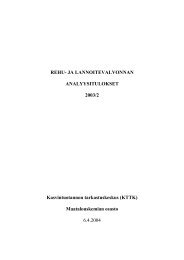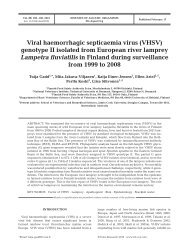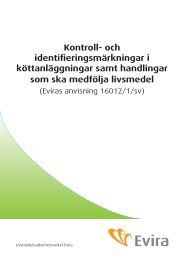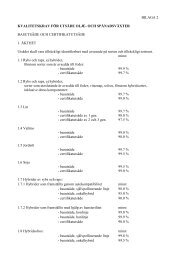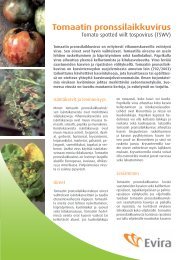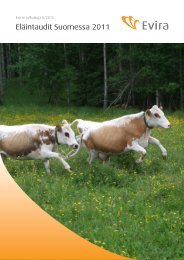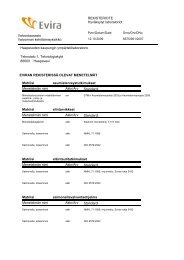Molecular characterization of endemic salmonella infections ... - Evira
Molecular characterization of endemic salmonella infections ... - Evira
Molecular characterization of endemic salmonella infections ... - Evira
You also want an ePaper? Increase the reach of your titles
YUMPU automatically turns print PDFs into web optimized ePapers that Google loves.
In 1977, 207 "definitive types" (DTs) <strong>of</strong> S. Typhimurium were defined by using 34 phages<br />
(Anderson et al 1977). A different typing system, in which typing with another set <strong>of</strong><br />
bacteriophages is supplemented by biotyping, is used in the Netherlands (Parker 1983, EFSA<br />
2005). Hungary also uses yet a different set <strong>of</strong> phages (EFSA 2005). Phage typing schemes have<br />
also been described for serovars Adelaide, Anatum, Bareilly, Blockley, Braenderup,<br />
Bovismorbificans, Enteritidis, Gallinarum, Hadar, Infantis, Montevideo, Newport, Panama,<br />
Paratyphi B, Virchow and Weltevreden (Grimont et al 2000). Recently a phage typing scheme for<br />
S. Agona was developed (Rabsch et al 2005).<br />
Phage typing is routinely used for subtyping isolates <strong>of</strong> S. Typhimurium as it is one <strong>of</strong> the basic<br />
methods employed in studying the epidemiology <strong>of</strong> this serovar. Even nowadays, when molecular<br />
methods are used for the subtyping <strong>of</strong> isolates, phage typing is still used. Phage-typing does not<br />
require any expensive equipment and is therefore cheap (Grimont et al 2000). However, stocks <strong>of</strong><br />
biologically active phages and control strains need to be maintained. Therefore phage typing is<br />
only available at reference laboratories. It is very demanding even for experienced workers, and<br />
subject to considerable biological and experimental variability (Maslow et al 1993). Moreover,<br />
when only a few phage types tend to dominate over a period <strong>of</strong> time, the discriminatory ability <strong>of</strong><br />
this typing method becomes diminished. In the 1990s, a multiresistant phage type <strong>of</strong> S.<br />
Typhimurium, DT104, emerged and spread in the UK, Denmark, USA and Canada (Kariuki et al<br />
1999). In 2004, the dominating S. Typhimurium phage types overall among isolates obtained from<br />
human <strong>infections</strong> in the EU were DT104 and DT120 (EFSA 2005).<br />
2.5.1.2 Antimicrobial susceptibility testing<br />
Salmonellae used to be susceptible to a wide range <strong>of</strong> antimicrobials in vitro. However, in 1958<br />
resistance to tetracycline was first noted. In 1962, resistance to ampicillin was reported in Britain<br />
and rapidly became common. Transferable resistances to streptomycin, tetracycline and<br />
sulphonamides were observed in a S. Typhimurium strain <strong>of</strong> phage type 29 from 1958, which by<br />
1968 had acquired a resistance spectrum with resistance to ampicillin, streptomycin,<br />
sulphonamide, tetracycline and furazolidone. Resistance to chloramphenicol and kanamycin was<br />
also reported (Parker 1983). Plasmids containing genes that confer resistance to antibiotics may<br />
readily be acquired by Salmonella strains (Brenner 1984). After 1976, resistant strains <strong>of</strong> S.<br />
Typhimurium phage types 204 and 193 caused epidemics in calves, with subsequent spread to<br />
man. Plasmids coding for resistance to four to six antimicrobials, including chloramphenicol, were<br />
carried by these strains (Parker 1983).<br />
23



